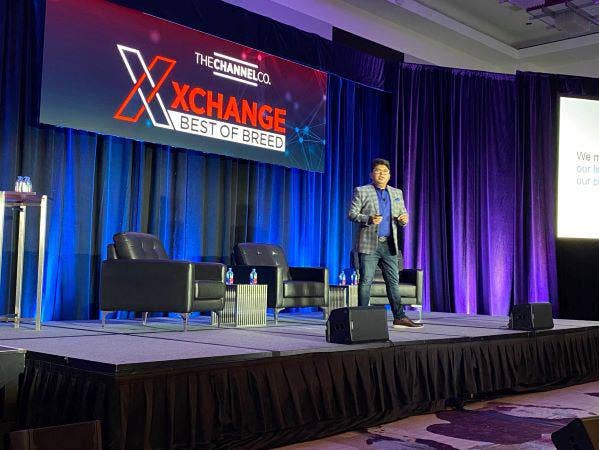Ingram Micro Executive On How To Evaluate Your Digital Fitness
‘My call to action for the channel is start understanding the experience of your end customers,’ he says. ‘Understand what problems they want to solve, understand how they can be better digitally fit. Every organization today is trying to stay relevant and stay digitally fit. We should be partners to help them solve that problem.’

Without digital fitness, there’s a good chance a company will fail, according to Sanjib Sahoo, executive vice president and chief digital officer for Irvine, Calif.-based distributor Ingram Micro.
Sahoo spoke to partners at The Channel Company’s Best of Breed (BoB) conference in Atlanta this week about changing one’s mindset and becoming a digitally fit company.
“There are many factors that drive physical fitness, it’s your health, your heart…everything,” he said. “Digital fitness is also related to the same thing, longevity of companies to stay relevant. It’s to really evaluate that it’s ongoing and it’s a mindset change.”
[Related: Ingram Micro’s Marketing Message To Partners: Embrace Your Brand]
To survive, Sahoo said companies need to stop talking about digital transformation and figure out if they are digitally fit, what level of fitness they are at and create a digital fitness regime. He added that companies also must check their digital BMI (body mass index).
“More than 40 percent of the companies on the Fortune 500 list will disappear from the list in the next 10 years,” he said. “It is not that it’s a luxury, it is a necessity.”
There are seven factors that influence a company’s digital BMI: legacy and core systems, data, customers experience, product mindset, balanced portfolio, innovate, operate and integrate and speed to market.
Partners must have nimble and flexible legacy and core systems, they must create a data foundation across all systems, figure out how to drive a better customer where the experience matters, have a product mindset to create a better user experience and innovate, operate and integrate all simultaneously.
There are four steps to creating a digital fitness regime, he said. The first is creating a spirit and the DNA of an organization–it’s a lifestyle change.
The second step is planning. Transformation cannot happen in isolation. Partners must make the digital journey part of their operations. Third is creating an architecture. Partners must figure out how to
decouple at the legacy layer, at the data layer and the experience layer.
“Start modernizing legacy at the same time, aggregating data at the same time and building your engines and architects in such a way that everything is decoupled and you can really move fast,” he said.
The last piece is building governance. Create a governance structure where it’s understood what is creating the value.
If a company embarks on digital transformation, more than 80 percent of such efforts fail, according to Sahoo. Companies must focus on being digitally fit.
“A lot of times we try to transform or innovate in isolation, “he said. “We build technology first and then try to do adoption. That doesn’t work anymore. The reason for that is it is ongoing.”
He said companies build technology and then try to adopt it, but in the meantime technology is already changing.
“You’ve got to do it together,” he said. “You have to start learning, operating and transforming together.”
But digitization isn’t automation, it’s all about experience.
“Every organization thinks about how do we make a better customer experience, employee experience, vendor experience,” he said. “Once you focus on the experience, automation follows.”
One way to think about it, he said, is the “Sunday, Monday experience.” If someone is watching a game on a Sunday night, they use a food delivery service to order a pizza. They may be ordering groceries the same way. Come Monday, though, an individual is asking what technologies and solutions they can buy.
“Why is this Sunday and Monday experience so different?” he said. “We have to focus on blending, that is digitalization. People think, ‘Let‘s automate. Let’s modernize our infrastructure. That is digitalization.’ They’re absolutely wrong. It is completely creating that blended experience and creating the consumerization.”
It’s also about digital operation and creating value.
“Companies who could not address the opportunity gap have fallen behind,” he said, adding that it’s all about humans, not the technology.
“We have to start selling experience,” he said. “Start understanding experience, then technology follows.”
Partners should also be chief value officers to clients, he said. Don’t just focus on the product, focus on the experience and the value.
What it comes down to, though, is changing the mindset.
“My call to action for the channel is start understanding the experience of your end customers,” he said. “Understand what problems they want to solve, understand how they can be better digitally fit. Every organization today is trying to stay relevant and stay digitally fit. We should be partners to help them solve that problem.”
Phil Walker, CEO of Manhattan Beach, Calif.-based MSP Network Solutions Provider, believes being digitally fit just makes sense.
“I think it’s something that everybody knows but I think that, to his point, everybody has been focused on the technology and not the employee culture,” Walker told CRN.
For his own company, he wants to change the conversation with clients around people.
“It’s still giving them emergent technology but really focusing on the business impact that the technology will have on their business,” he said.